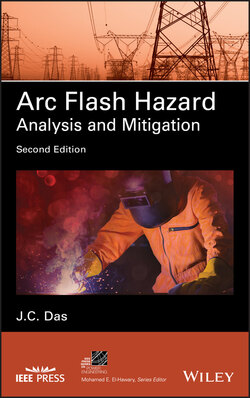Читать книгу Arc Flash Hazard Analysis and Mitigation - J. C. Das - Страница 38
1.14 EXAMPLES OF CALCULATIONS Example 1.1
ОглавлениеThis example is for calculations as per 2002 Guide. It is included here for reference. The results are compared with 2018 methodology in Chapter 3.
Calculate the incident energy using IEEE equations for a 30-kA three-phase bolted fault current in a 13.8-kV metal-clad switchgear, resistance grounded. The arcing time is 30 cycles for the arc fault current through the protective device.
Using IEEE Equation (1.11), calculate arcing current:
This gives Ia = 28.578 kA. Note that the arc flash time is calculated based upon the arcing fault current through the protective device and not the bolted fault current. A further calculation for arc flash time is required at 0.85Ia. Let us assume for this example that 30 cycles is applicable even for reduced 0.85Ia. Then, calculate normalized incident energy from Equation (1.12):
Here, K1 = −0.555 (arc in a box), K2 = −0.113, resistance grounded system, and G = 153 mm (Table 1.5). This gives log En = 1.074. Calculate incident energy in J/cm2 using Equation (1.13):
Here, t is the arcing time = 0.5 second, the distance x is given in Table 1.7, and for 15 kV, it is 0.973, and D, the working distance from Table 1.6, is 910 mm.
This gives E = 84.4 J/cm2 = 20.08 cal/cm2.
Calculate the arc flash boundary (see Equation 1.15):
Here, Cf = 1, En as calculated before is 11.858 J/cm2, EB = 5 J/cm2 by definition. This gives DB = 16,541 mm = 54.267 ft. This is rather a large distance at which a worker can get threshold of second-degree burns.
